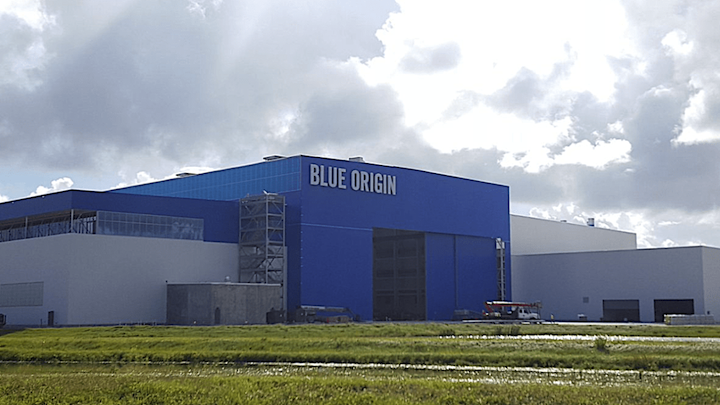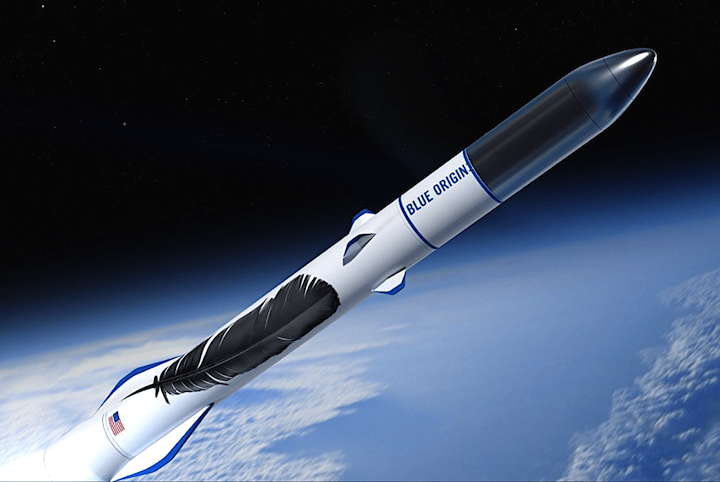17.10.2017

Blue Origin’s New Glenn rocket production plant at Kennedy Space Center, Florida. The vehicle is too big to be carried over public roads, so it’s manufactured just 11 kilometers from its launch site.
TOKYO — Being a start-up launch-service provider backed big-time by Amazon founder Jeff Bezos means never having to to financial roadshows or smile to venture-capital investors.
That’s the enviable position of Blue Origin, which is honing a space-tourism vehicle called New Shepard and building a very large rocket called New Glenn.
Bezos has agreed to invest around $2.5 billion in New Glenn, which should be in service within four years. A year before that, the New Glenn first-stage engine, called BE-4, is likely to be in service by United Launch Service, the operator of today’s Atlas 5 and Delta 4 rockets, mainly for U.S. government missions.
Blue Origin has signed contracts with broadband constellation startup operator OneWeb, for launches of an undetermined number of OneWeb spacecraft into low Earth orbit; and with established fleet operator Eutelsat for a launch to geostationary orbit in 2021 or 2022.
Blue Origin recently signed a cooperation agreement with Mu Space of Thailand involving both New Glenn and a space-tourism business Mu Space plans. But Mu Space is far from being able to sign contracts for either idea as it ramps up its current VSAT network and prepares to transition into a satellite operator.
Addressing the APSCC 2017 conference here Blue Origin Director Ted McFarland said the company is still looking for a customer for New Glenn’s inaugural flight in 2020 or 2021.
Here are excerpts from McFarland’s remarks at the conference on the New Glenn schedule and how Blue Origin views its role in the most lucrative launch-services market in the world, which is serving U.S. government demand.
Jeff Bezos said something like, “All my overnight successes take 10 years,” which is true for Blue Origin. You look new, but you’ve been in business for awhile.
We have been a well-guarded secret. Blue Origin has been in business since 2000. The original idea was to look at different ways to fly into space. That evolved into an engine house. We are now flying BE-3 engines on New Shepard and testing the large BE-4 engine at this time. At our core we are a propulsion company, building our own engines.
We also sell those engines to other companies, such as United Launch Alliance, which is considering us for the new Vulcan rocket. And we have entertained discussions with launch vehicle manufacturers around the world. There has been discussion of that potential. This is all Jeff Bezos’s money, his company and his interest in getting to space.
We have been through a series of vehicle productions and now flying a Lox/H2 vehicle with a capsule and using it for testing to learn how to apply this technology to lead us to New Glenn.
We announced our vision of carrying millions of people into space. That is the New Glenn vehicle.
There will be other vehicles to come after this.
New Shepard uses seven BE-4 engines in its core stage. Our engine testing facility, in West Texas, is one of the busiest in the world. We have leased pad 36A and 36B at Cape Canaveral. We are building a very large launch site and, 11 km away, a large factory.
The vehicle itself is 7 meters in diameter. It is quite large. It won’t fit on the highways and wont go under bridges, so it is built at the launch site and moved physically and integrated at the launch site, hydraulically raised at the launch site.
WE have started to build the initial tank structures for New Glenn in Florida.

The Blue Origin New Glenn rocket. The 7-meter-diameter fairing was decided on with an eye to the future market for low-orbiting constellations of broadband communications satellites. Credit: Blue Origin
There will be announcements coming soon about New Shepard returning to flight, about our ambition is to put humans in the capsule by mid-2018 and key developments on New Glenn.
What’s the current development schedule for New Glenn?
We are offering the New Glenn to an initial tranche of first movers if you will, available from the end of 2020 to the end of 2021 for the first, and then 2022 and 2023 and 2024, pacing out for those first five.
And its performance to GEO and LEO?
Thirteen metric tonnes to GEO for a two-stage vehicle; and 46 metric tonnes to LEO. We are not going to release all that on the first tranche. On our first outing, we will be flying the stage back. We are going to keep margin back so we have adequate reserves to recover the first test article.
We will be selling that first launch. If anyone would like to be the first mover on a brand-new rocket, we have that position still available — nice pricing, by the way. It will be very competitive. Our objective is very low cost per kilo to orbit.
ULA is expected to make an engine selection this year?
Yes. ULA is designing a new vehicle, two-engine successor to the Atlas called Vulcan 2 and BE-4 engines for the first stage for over 1 million pounds of thrust. it will be an expendable vehicle for the U.S. government.
We have had United Launch Alliance workers in our factory for the last two years on this and they are comfortable with the selection process. As soon as we complete our test demonstration milestones and repeatability on the 550,000 pounds of thrust [per engine], we believe they will place the order with us. At that point we will stand up a rate production facility in Huntsville, Alabama.
That’s where we will build the series production of the BE-4.
Can you sell New Glenn for U.S. government use even as you supply BE-4 engines to ULA?
Becoming a government supplier doesn’t happen overnight. There is a series of certifications one has to go through. Right now having ULA using our engines and qualifying our engines into that supply system is a good thing for us. They will fly a year ahead of us, in 2019. We will come into the market in end of 2020, 2021. And at that point if we choose to go into government contracting, it will imply setting up cost accounting systems that are geared to the government.
I don’t think there will be any issue downstream.
In your view, how many broadband satellite constellations are likely to be developed?
We have a signed agreement for OneWeb’s generation two, so OneWeb is here to stay and I believe there are probably at least two more if they have access to capital.
Quelle: Space Intel Report
